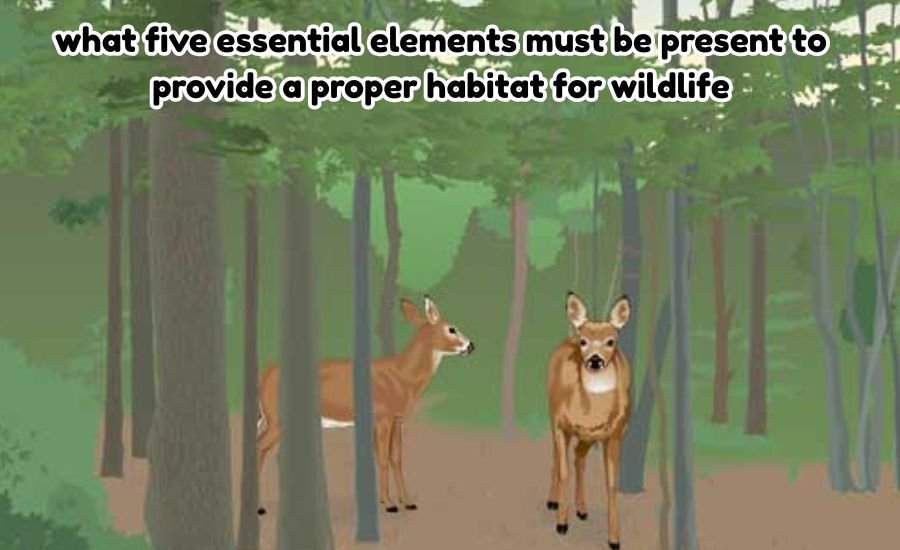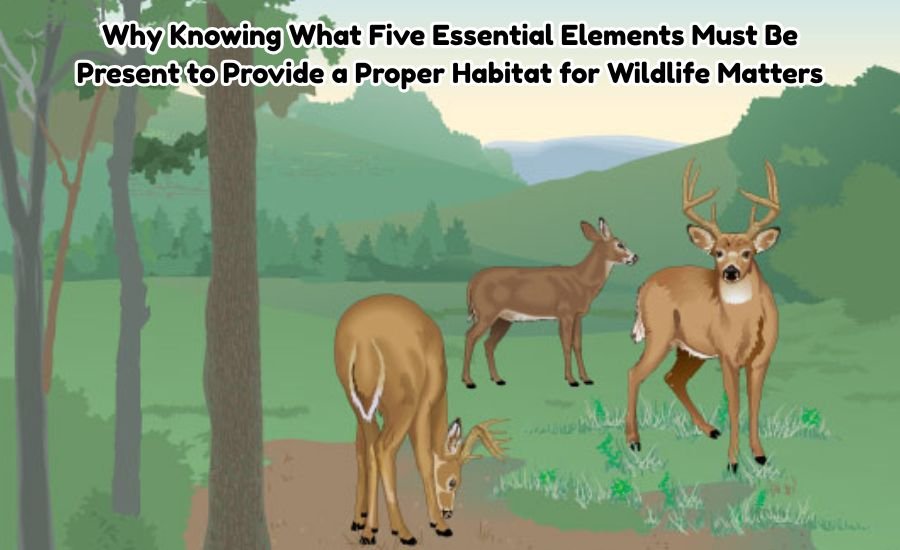Wildlife survival is deeply tied to the quality and characteristics of their habitats. Knowing what five essential elements must be present to provide a proper habitat for wildlife is fundamental for conserving natural environments and supporting biodiversity. Every species, whether large or small, depends on specific habitat features that meet their basic needs. This article thoroughly explains these five vital elements that form the backbone of a healthy wildlife habitat.
Protecting these elements is key to ensuring animals have the resources needed to live, reproduce, and maintain balanced ecosystems. By understanding these core components, we can make better decisions about conservation and land use that benefit both wildlife and humans.
Understanding What Five Essential Elements Must Be Present to Provide a Proper Habitat for Wildlife
A wildlife habitat is not just a physical space it’s a dynamic, living system that supplies everything animals require for survival. To grasp what five essential elements must be present to provide a proper habitat for wildlife, we need to look beyond surface-level factors. These elements include resources and environmental conditions that directly influence an animal’s ability to live safely and thrive.
Habitats vary in appearance and climate worldwide, yet the requirements for food, water, shelter, space, and breeding conditions remain universal. These five elements interact closely, shaping ecosystems and influencing wildlife behaviors. When one element is missing or compromised, it can disrupt the entire balance, causing populations to decline or forcing animals to migrate in search of better environments.
The First Element Food Availability
Food is the lifeblood of wildlife, making it the first critical factor in answering what five essential elements must be present to provide a proper habitat for wildlife. Different species have varied diets herbivores feed on plants, carnivores hunt other animals, and omnivores consume both. Regardless of diet type, the availability of sufficient, nutritious food directly affects an animal’s health, growth, and ability to reproduce.
Habitats rich in diverse plant species, insects, and prey animals can support more complex food webs and sustain larger populations. Seasonal changes often affect food supply; for example, some areas may have abundant food in spring and summer but scarce resources in winter. Therefore, wildlife depends on either year-round food availability or the ability to move to new areas during lean seasons.
The Second Element: Water Sources
Water is an essential, non-negotiable element in understanding what five essential elements must be present to provide a proper habitat for wildlife. It is fundamental not only for hydration but also for physiological functions, thermoregulation, and reproduction in many species.Natural water sources include rivers, lakes, ponds, wetlands, and even seasonal pools. Some species require permanent water bodies, while others can survive with temporary or rain-fed water sources.
Clean, uncontaminated water is especially critical, as polluted water can cause disease and mortality in wildlife populations.Additionally, water bodies often serve as breeding sites for amphibians, fish, and certain insects. The surrounding vegetation benefits from water availability, creating rich habitats for herbivores and the animals that prey on them. Protecting water quality and availability is therefore a top priority in habitat conservation.
The Third Element: Shelter and Cover

Shelter is the third indispensable answer to what five essential elements must be present to provide a proper habitat for wildlife. Animals require safe places to rest, hide from predators, escape harsh weather, and raise their young. Shelter comes in many forms dense foliage, tree canopies, caves, hollow logs, burrows, or even rocky outcrops.Different species have different shelter needs.
Birds may require tall trees or shrubs for nesting, while mammals might depend on underground dens or thickets. Proper shelter helps reduce stress and vulnerability, directly contributing to an animal’s survival chances.Habitat degradation often results in loss of shelter, exposing wildlife to predators and extreme weather. Restoration projects work to increase structural diversity in habitats by planting native trees, maintaining undergrowth, or installing artificial shelters where necessary.
The Fourth Element: Space or Territory
Adequate space is crucial when considering what five essential elements must be present to provide a proper habitat for wildlife. Animals need enough room to find food, establish territories, reproduce, and migrate. Overcrowding can cause competition for resources, increased aggression, disease spread, and reduced reproductive success.Space requirements vary greatly among species. Large mammals may need expansive territories, while smaller animals can thrive in more confined areas.
Connectivity between habitat patches is also vital to allow safe movement, genetic exchange, and adaptation to environmental changes.Fragmentation of habitats by roads, urban development, and agriculture disrupts these spaces, isolating populations and reducing biodiversity. Conservation strategies emphasize preserving continuous habitat areas and establishing wildlife corridors to link isolated patches.
The Fifth Element: Suitable Breeding Conditions
Breeding conditions complete the list of what five essential elements must be present to provide a proper habitat for wildlife. Successful reproduction is the key to species survival and population growth. Habitats must provide the right environmental factors such as temperature, humidity, nesting materials, and safety from predators.Many species have very specific breeding requirements. For example, sea turtles need sandy beaches for nesting, amphibians require clean freshwater bodies for egg-laying, and certain birds depend on particular trees or cliffs.
Disruption of these breeding sites can have severe consequences on population viability.Protecting and managing breeding habitats is a cornerstone of wildlife conservation. Ensuring these areas remain undisturbed during critical breeding seasons increases the chances of raising healthy offspring.
Crucial Point You Must Understand: Which-is-a-wildlife-characteristic-to-consider-when-identifying-game
Five Essential Elements for Wildlife Habitats
| Essential Element | Description | Importance to Wildlife |
| Food Availability | Access to a variety of food sources suitable for species | Provides necessary energy, nutrients, and sustenance |
| Water Sources | Clean and reliable water bodies like rivers and ponds | Supports hydration, thermoregulation, reproduction |
| Shelter and Cover | Natural or artificial places offering protection and nesting | Offers safety, rest areas, and secure breeding locations |
| Space or Territory | Adequate area for movement, foraging, and breeding | Prevents overcrowding and promotes natural behavior |
| Suitable Breeding Conditions | Environmental factors critical for reproduction success | Ensures survival of offspring and population sustainability |
Why Knowing What Five Essential Elements Must Be Present to Provide a Proper Habitat for Wildlife Matters

Awareness of what five essential elements must be present to provide a proper habitat for wildlife is vital for anyone involved in environmental management or conservation. Each element plays a unique role in the survival and health of animal populations, and together they create balanced ecosystems.Wildlife loss and habitat degradation caused by human activities threaten these essential elements.
Deforestation, water pollution, urban expansion, and climate change are altering habitats at alarming rates. Without protecting the food, water, shelter, space, and breeding conditions, many species face extinction.Understanding these five elements guides effective conservation planning, habitat restoration, and environmental education. It also helps governments and organizations create policies that support sustainable land use, wildlife corridors, and protected areas.
How To Help Maintain the Five Essential Elements for Wildlife Habitats
Individual and community efforts can significantly impact habitat preservation once they understand what five essential elements must be present to provide a proper habitat for wildlife. Planting native vegetation provides food and shelter, while protecting wetlands and rivers helps maintain water quality.Creating wildlife-friendly gardens with diverse plants, water sources, and safe hiding spots supports local species.
Avoiding the use of pesticides and pollutants further protects food and water sources. Supporting conservation organizations and advocating for habitat protection are also effective ways to contribute.Education plays a key role in spreading knowledge about these habitat essentials. Communities that understand these five elements are more likely to take proactive steps to safeguard their local wildlife habitats.
Conclusion
In summary, identifying what five essential elements must be present to provide a proper habitat for wildlife highlights the interconnected needs of animals for survival and reproduction. Food, water, shelter, space, and suitable breeding conditions form the foundation of sustainable habitats.
Protecting these elements not only benefits wildlife but also supports ecosystem services that humans rely on, including clean air, water filtration, and pollination. By committing to preserving and restoring these habitat components, we help ensure a vibrant, diverse natural world for future generations.
You Should Be Aware Of: Emerald-coast-wildlife-refuge-a-sanctuary-for-floridas-wildlife
FAQs
What five essential elements must be present to provide a proper habitat for wildlife?
The five essential elements are food, water, shelter, space, and suitable breeding conditions.
Why is it important to know what five essential elements must be present to provide a proper habitat for wildlife?
Knowing these elements helps protect and restore habitats that support healthy wildlife populations.
How does food fit into what five essential elements must be present to provide a proper habitat for wildlife?
Food is a critical element, supplying energy and nutrients necessary for animals’ survival and reproduction.
What role does water play in what five essential elements must be present to provide a proper habitat for wildlife?
Water provides hydration, supports physiological needs, and is vital for many species’ breeding processes.
Is shelter included in what five essential elements must be present to provide a proper habitat for wildlife?
Yes, shelter offers protection from predators and harsh weather and helps animals rest and reproduce safely.